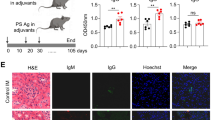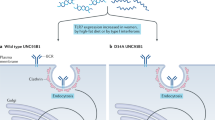Abstract
Glucocorticoids are widely used to treat patients with autoimmune diseases such as systemic lupus erythematosus (SLE)1,2. However, regimens used to treat many such conditions cannot maintain disease control in the majority of SLE patients and more aggressive approaches such as high-dose methylprednisolone pulse therapy are used to provide transient reductions in disease activity3,4. The primary anti-inflammatory mechanism of glucocorticoids is thought to be NF-κB inhibition5. Recognition of self nucleic acids by toll-like receptors TLR7 and TLR9 on B cells and plasmacytoid dendritic cells (PDCs) is an important step in the pathogenesis of SLE6, promoting anti-nuclear antibodies and the production of type I interferon (IFN), both correlated with the severity of disease1,7. Following their activation by self-nucleic acid-associated immune complexes, PDCs migrate to the tissues8,9. We demonstrate, in vitro and in vivo, that stimulation of PDCs through TLR7 and 9 can account for the reduced activity of glucocorticoids to inhibit the IFN pathway in SLE patients and in two lupus-prone mouse strains. The triggering of PDCs through TLR7 and 9 by nucleic acid-containing immune complexes or by synthetic ligands activates the NF-κB pathway essential for PDC survival. Glucocorticoids do not affect NF-κB activation in PDCs, preventing glucocorticoid induction of PDC death and the consequent reduction of systemic IFN-α levels. These findings unveil a new role for self nucleic acid recognition by TLRs and indicate that inhibitors of TLR7 and 9 signalling could prove to be effective corticosteroid-sparing drugs.
This is a preview of subscription content, access via your institution
Access options
Subscribe to this journal
Receive 51 print issues and online access
$199.00 per year
only $3.90 per issue
Buy this article
- Purchase on SpringerLink
- Instant access to full article PDF
Prices may be subject to local taxes which are calculated during checkout




Similar content being viewed by others
References
Hahn, B. H. Antibodies to DNA. N. Engl. J. Med. 338, 1359–1368 (1998)
Chatham, W. W. & Kimberly, R. P. Treatment of lupus with corticosteroids. Lupus 10, 140–147 (2001)
Franchin, G. & Diamond, B. Pulse steroids: how much is enough? Autoimmun. Rev. 5, 111–113 (2006)
Parker, B. J. & Bruce, I. N. High dose methylprednisolone therapy for the treatment of severe systemic lupus erythematosus. Lupus 16, 387–393 (2007)
De Bosscher, K., Vanden Berghe, W. & Haegeman, G. The interplay between the glucocorticoid receptor and nuclear factor-κB or activator protein-1: molecular mechanisms for gene repression. Endocr. Rev. 24, 488–522 (2003)
Barrat, F. J. & Coffman, R. L. Development of TLR inhibitors for the treatment of autoimmune diseases. Immunol. Rev. 223, 271–283 (2008)
Banchereau, J. & Pascual, V. Type I interferon in systemic lupus erythematosus and other autoimmune diseases. Immunity 25, 383–392 (2006)
Wenzel, J. & Tüting, T. An IFN-associated cytotoxic cellular immune response against viral, self-, or tumor antigens is a common pathogenetic feature in “interface dermatitis”. J. Invest. Dermatol. 128, 2392–2402 (2008)
Tucci, M. et al. Glomerular accumulation of plasmacytoid dendritic cells in active lupus nephritis: role of interleukin-18. Arthritis Rheum. 58, 251–262 (2008)
Chaussabel, D. et al. A modular analysis framework for blood genomics studies: application to systemic lupus erythematosus. Immunity 29, 150–164 (2008)
Barrat, F. J. et al. Nucleic acids of mammalian origin can act as endogenous ligands for Toll-like receptors and may promote systemic lupus erythematosus. J. Exp. Med. 202, 1131–1139 (2005)
Shodell, M., Shah, K. & Siegal, F. P. Circulating human plasmacytoid dendritic cells are highly sensitive to corticosteroid administration. Lupus 12, 222–230 (2003)
Montague, J. W. & Cidlowski, J. A. Glucocorticoid-induced death of immune cells: mechanisms of action. Curr. Top. Microbiol. Immunol. 200, 51–65 (1995)
Boor, P. P. et al. Prednisolone suppresses the function and promotes apoptosis of plasmacytoid dendritic cells. Am. J. Transplant. 6, 2332–2341 (2006)
Takauji, R. et al. CpG-DNA-induced IFN-α production involves p38 MAPK-dependent STAT1 phosphorylation in human plasmacytoid dendritic cell precursors. J. Leukoc. Biol. 72, 1011–1019 (2002)
Guiducci, C. et al. PI3K is critical for the nuclear translocation of IRF-7 and type I IFN production by human plasmacytoid predendritic cells in response to TLR activation. J. Exp. Med. 205, 315–322 (2008)
Strickland, I. et al. High constitutive glucocorticoid receptor β in human neutrophils enables them to reduce their spontaneous rate of cell death in response to corticosteroids. J. Exp. Med. 193, 585–594 (2001)
Rozzo, S. J. et al. Evidence for an interferon-inducible gene, Ifi202, in the susceptibility to systemic lupus. Immunity 15, 435–443 (2001)
Santiago-Raber, M. L. et al. Type-I interferon receptor deficiency reduces lupus-like disease in NZB mice. J. Exp. Med. 197, 777–788 (2003)
Mathian, A., Weinberg, A., Gallegos, M., Banchereau, J. & Koutouzov, S. IFN-α induces early lethal lupus in preautoimmune (New Zealand Black × New Zealand White)F1 but not in BALB/c mice. J. Immunol. 174, 2499–2506 (2005)
Agrawal, H. et al. Deficiency of type I IFN receptor in lupus-prone New Zealand mixed 2328 mice decreases dendritic cell numbers and activation and protects from disease. J. Immunol. 183, 6021–6029 (2009)
Barrat, F. J., Meeker, T., Chan, J. H., Guiducci, C. & Coffman, R. L. Treatment of lupus-prone mice with a dual inhibitor of TLR7 and TLR9 leads to reduction of autoantibody production and amelioration of disease symptoms. Eur. J. Immunol. 37, 3582–3586 (2007)
Deane, J. A. et al. Control of Toll-like receptor 7 expression is essential to restrict autoimmunity and dendritic cell proliferation. Immunity 27, 801–810 (2007)
Athens, J. W. et al. Leukokinetic studies. IV. The total blood, circulating and marginal granulocyte pools and the granulocyte turnover rate in normal subjects. J. Clin. Invest. 40, 989–995 (1961)
Laakko, T. & Fraker, P. Rapid changes in the lymphopoietic and granulopoietic compartments of the marrow caused by stress levels of corticosterone. Immunology 105, 111–119 (2002)
Trottier, M. D., Newsted, M. M., King, L. E. & Fraker, P. J. Natural glucocorticoids induce expansion of all developmental stages of murine bone marrow granulocytes without inhibiting function. Proc. Natl Acad. Sci. USA 105, 2028–2033 (2008)
Bennett, L. et al. Interferon and granulopoiesis signatures in systemic lupus erythematosus blood. J. Exp. Med. 197, 711–723 (2003)
Duramad, O. et al. Inhibitors of TLR-9 act on multiple cell subsets in mouse and man in vitro and prevent death in vivo from systemic inflammation. J. Immunol. 174, 5193–5200 (2005)
Geiss, G. K. et al. Direct multiplexed measurement of gene expression with color-coded probe pairs. Nature Biotechnol. 26, 317–325 (2008)
Guiducci, C. et al. Properties regulating the nature of the plasmacytoid dendritic cell response to Toll-like receptor 9 activation. J. Exp. Med. 203, 1999–2008 (2006)
Acknowledgements
We would like to thank A. O’Garra, G. Trinchieri, J.-L. Casanova and our colleagues at Dynavax Technologies for their critical reading of the manuscript. We thank S. Noonan and H. Lopez (Murigenics) for invaluable assistance with animal work. This work was supported by NIH grants P50-ARO54083-01CORT, U19-AI082715-01, The Alliance for Lupus Research, The Mary Kirkland Foundation (to V.P.) and SBIR grant 2R44AI066483-02 (to R.L.C.).
Author information
Authors and Affiliations
Contributions
C.G. and F.J.B. designed the study; C.G., M.Go., Z.X., M.Gi., T.M. and J.H.C. performed experiments; D.C., V.P., C.G. and F.J.B. collected and analysed data; S.B. provided the mice; T.W. and M.P. followed the cohort of patients and provided clinical samples; C.G., Z.X., R.L.C., V.P. and F.J.B wrote the manuscript; V.S., J.B. and R.L.C. gave conceptual advice.
Corresponding author
Ethics declarations
Competing interests
C.G., M.Go., T.M., J.H.C., R.L.C. and F.J.B. are full-time employees of Dynavax Technologies.
Supplementary information
Supplementary Information
This file contains Supplementary Figures 1-7 with legends and Supplementary Tables 1-2. (PDF 349 kb)
Rights and permissions
About this article
Cite this article
Guiducci, C., Gong, M., Xu, Z. et al. TLR recognition of self nucleic acids hampers glucocorticoid activity in lupus. Nature 465, 937–941 (2010). https://doi.org/10.1038/nature09102
Received:
Accepted:
Issue Date:
DOI: https://doi.org/10.1038/nature09102
This article is cited by
-
Autoimmunity and organ damage in systemic lupus erythematosus
Nature Immunology (2020)
-
Plasmacytoid dendritic cell deficiency in neonates enhances allergic airway inflammation via reduced production of IFN-α
Cellular & Molecular Immunology (2020)
-
Neutrophil extracellular trap-associated RNA and LL37 enable self-amplifying inflammation in psoriasis
Nature Communications (2020)
-
Toll-like receptors activation, signaling, and targeting: an overview
Bulletin of the National Research Centre (2019)
-
Safety, tolerability, pharmacokinetics, and pharmacodynamics of PF-06650833, a selective interleukin-1 receptor-associated kinase 4 (IRAK4) inhibitor, in single and multiple ascending dose randomized phase 1 studies in healthy subjects
Arthritis Research & Therapy (2019)



